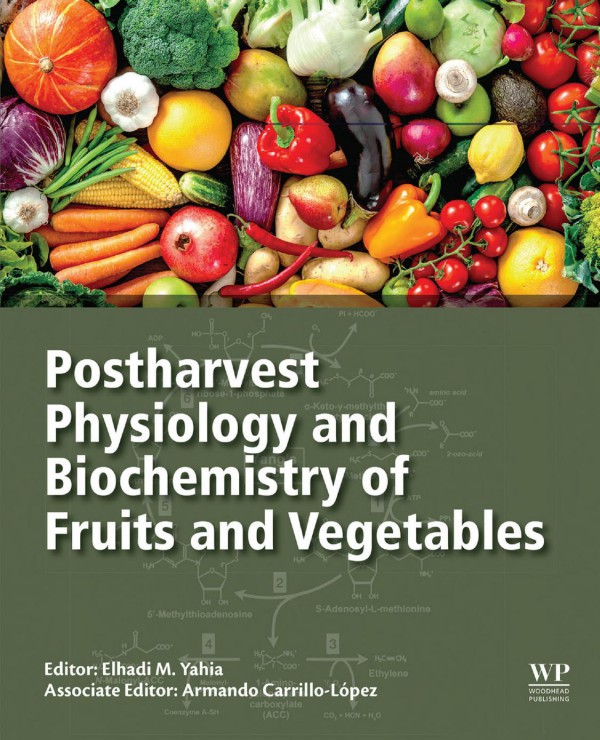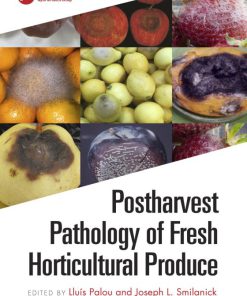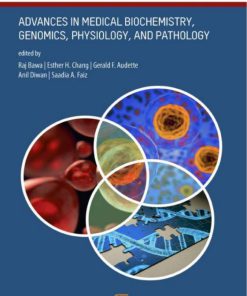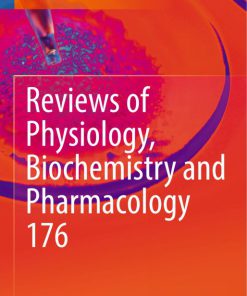Postharvest Physiology and Biochemistry of Fruits and Vegetables 1st Edition by Elhadi Yahia, Armando Carrillo Lopez 0128132787 9780128132784
$50.00 Original price was: $50.00.$25.00Current price is: $25.00.
Authors:Elhadi M. Yahia; Armando Carrillo-Lopez , Series:Physiology [8] , Tags:Technology & Engineering; Agriculture; Agronomy; Crop Science; General; Science; Life Sciences; Botany; Food Science , Author sort:Yahia, Elhadi M. & Carrillo-Lopez, Armando , Ids:9780128132784 , Languages:Languages:eng , Published:Published:Nov 2018 , Publisher:Elsevier Science , Comments:Comments:Postharvest Physiology and Biochemistry of Fruits and Vegetables presents an updated, interrelated and sequenced view of the contribution of fruits and vegetables on human health, their aspects of plant metabolism, physical and chemical/compositional changes during the entire fruit development lifecycle, the physiological disorders and biochemical effects of modified/controlled atmospheres, and the biotechnology of horticultural crops. The book is written specifically for those interested in preharvest and postharvest crop science and the impact of physiological and biochemical changes on their roles as functional foods.
Postharvest Physiology and Biochemistry of Fruits and Vegetables 1st Edition by Elhadi Yahia, Armando Carrillo Lopez – Ebook PDF Instant Download/Delivery. 0128132787, 9780128132784
Full download Postharvest Physiology and Biochemistry of Fruits and Vegetables 1st Edition after payment
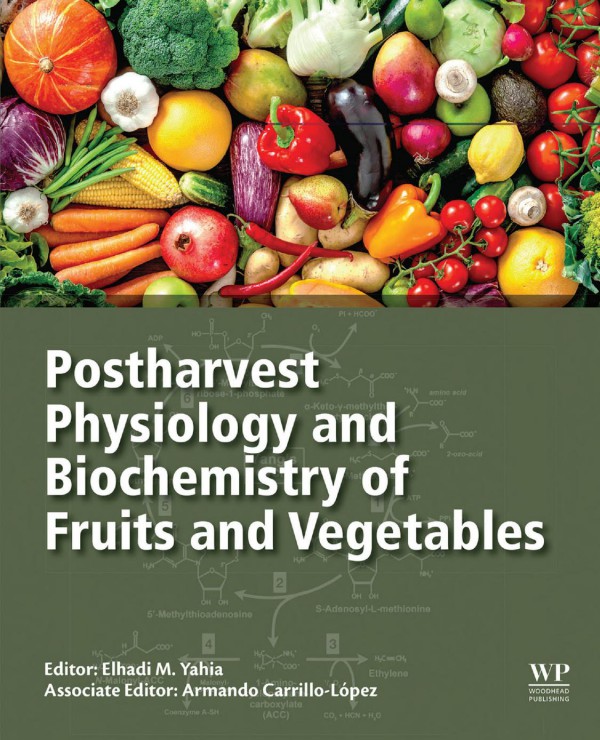
Product details:
ISBN 10: 0128132787
ISBN 13: 9780128132784
Author: Elhadi M. Yahia; Armando Carrillo-Lopez
Postharvest Physiology and Biochemistry of Fruits and Vegetables presents an updated, interrelated and sequenced view of the contribution of fruits and vegetables on human health, their aspects of plant metabolism, physical and chemical/compositional changes during the entire fruit development lifecycle, the physiological disorders and biochemical effects of modified/controlled atmospheres, and the biotechnology of horticultural crops. The book is written specifically for those interested in preharvest and postharvest crop science and the impact of physiological and biochemical changes on their roles as functional foods.
- Deals with the developmental aspects of the lifecycle in whole fruits
- Describes issues, such as the morphology and anatomy of fruits, beginning with the structural organization of the whole plant and explaining the fruit structure and its botanical classification
- Addresses biotechnological concepts that control firmness, quality and the nutritional value of fruits
Postharvest Physiology and Biochemistry of Fruits and Vegetables 1st Table of contents:
1 Introduction
1.1 Introduction
1.2 The Importance of Fruits and Vegetables in Human Nutrition and Health
1.3 Fruit and Vegetable Development
1.4 Postharvest Physiology and Biochemistry
1.5 Biochemical Parameters of Horticultural Crop Quality
1.6 Postharvest Factors Affecting Fruit Physiology and Biochemistry
1.7 Molecular Biology and Biotechnology
1.8 Research on Postharvest Physiology and Biochemistry
1.9 Conclusions
Further Reading
2 Contribution of Fruits and Vegetables to Human Nutrition and Health
2.1 Introduction
2.2 Health-Promoting Components in Fruits and Vegetables
2.2.1 Dietary Fiber
2.2.2 Vitamins
2.2.3 Minerals
2.2.4 Carotenoids
2.2.5 Phytoesterols
2.2.6 Phenolic Compounds
2.3 Contribution of Fruit and Vegetable Consumption to the Prevention of Various Diseases
2.3.1 Cancer
2.3.1.1 Chemoprevention of Carcinogenesis by Phytochemicals
2.3.2 Cardiovascular Disease
2.3.2.1 Hypertension
2.3.2.2 Chronic Heart Failure
2.3.3 Diabetes Mellitus
2.3.4 Overweight and Obesity
2.3.5 Pulmonary Health
2.3.6 Bone Health
2.3.7 Cataracts and Eye Health
2.3.8 Arthritis
2.3.9 Birth Defects
2.3.10 Diverticulosis
2.3.11 Skin Diseases
2.3.12 Neurodegenerative Diseases
2.4 Summary and Conclusions
References
Further Reading
3 Photosynthesis
3.1 Introduction
3.2 The Leaf and Its Structure
3.2.1 Mesophyll Cells and Stomata
3.2.2 Chloroplasts
3.3 Light Absorption
3.3.1 Pigments and Photosynthesis
3.3.2 Photosystems
3.4 Light-Dependent Reaction in Photosynthesis
3.4.1 Cyclic and Noncyclic Photophosphorylation
3.4.2 Cyclic Photophosphorylation
3.4.3 Noncyclic Photophosphorylation
3.5 Carbon Dioxide Fixation (Photosynthesis C3)
3.6 Photorespiration (Also Called Photosynthesis C2)
3.7 Photosynthesis C4 and Crassulacean Acid Metabolism
3.7.1 C4 Photosynthetic Metabolism
3.7.2 Crassulacean Acid Metabolism
3.8 Photosynthetic Adaptations to Different Environmental Conditions
3.8.1 Light Quality (Wavelength)
3.8.2 Light Intensity (Brightness)
3.8.3 Duration of Light (Photoperiod)
3.8.4 Concentration of Carbon Dioxide
3.8.5 Temperature
3.8.6 Availability of Water and Nutrients
3.8.7 Photosynthetic Groups Around the World
3.9 Photosynthesis in Fruits
3.10 Measurements of Photosynthetic Activity
Further Reading
4 Respiratory Metabolism
4.1 Introduction
4.2 Control of Respiratory Metabolism
4.2.1 Temperature
4.2.2 Altered Gaseous Atmospheres
4.2.2.1 Controlled and Modified Atmosphere Storage
4.2.2.2 Lower Pressure Storage
4.3 Measuring Respiration
4.3.1 The Static System
4.3.2 The Flow-Through System
4.4 Respiratory Quotient
4.5 Primary Reaction of Respiratory Metabolism
4.5.1 Glycolysis
4.5.2 Pentose–Phosphate Shunt
4.5.3 Acetyl-Coenzyme A
4.5.4 Synthesis of Fatty Acids
4.5.5 Anaerobic Respiration
4.5.6 Citric Acid Cycle
4.5.7 Chemiosmotic Phosphorylation (Aka Electron Transport)
4.6 Factors Affecting Respiratory Metabolism
4.6.1 Maturity and Fruit Ripening
4.6.2 Biotic and Abiotic Stresses
4.6.3 Chilling and Freezing Temperatures
4.7 Conclusion
References
Further Reading
5 Biology and Biochemistry of Ethylene
5.1 Introduction
5.2 Ethylene Biosynthesis, Perception, and Signal Transduction
5.2.1 The Ethylene Biosynthetic Pathway: Yang’s Cycle
5.2.2 Ethylene Perception and Signal Transduction
5.2.3 Ethylene Quantification
5.3 Ethylene Physiology and Crosstalk With Other Hormones During Postharvest
5.4 The Impact of Postharvest Conditions on Ethylene Physiology
5.4.1 Temperature
5.4.2 Atmosphere Composition
5.4.3 Other Postharvest Treatments
5.4.4 Specific Inhibitors of Ethylene Biosynthesis and Perception
5.5 Biotechnological Approaches
References
Further Reading
6 Morphology and Anatomy
6.1 Introduction
6.2 Structural Organization of Plants (Root and Shoot Systems)
6.3 Fruit and Vegetable Anatomy
6.3.1 Dermal System
6.3.1.1 Epidermal Cells
6.3.1.2 The Cuticular Membrane
6.3.1.3 The Trichomes
6.3.1.4 The Stomata
6.3.1.5 The Lenticels
6.3.2 Ground System
6.3.2.1 Parenchyma Tissue
6.3.2.2 Collenchyma Tissue
6.3.2.3 Sclerenchyma Tissue
6.3.3 Vascular System
6.3.3.1 Xylem
6.3.3.2 Phloem
6.4 The Root
6.5 The Stem
6.6 The Leaf
6.7 The Fruit
6.7.1 Parts of the Fruit
6.7.1.1 The Pericarp
The Epicarp
The Mesocarp
The Endocarp
6.7.1.2 The Seed
6.7.2 Classification of Fruits
6.8 Summary and Conclusions
Acknowledgments
Further Reading
7 Ripening and Senescence
7.1 Introduction
7.2 Regulation of Fruit Ripening
7.2.1 Climacteric and Nonclimacteric Ripening
7.2.2 Ethylene Biosynthesis and Perception
7.2.3 Transcriptional and Epigenetic Regulation
7.2.4 Interaction With Plant Hormones
7.3 Ethylene-Dependent and -Independent Fruit-Ripening Events
7.4 Changes in Fruit Color
7.4.1 Chlorophylls
7.4.2 Carotenoids
7.4.3 Anthocyanins
7.5 Fruit Softening
7.6 Flavor and Aroma Volatiles
7.7 Organic Acids
7.8 Carbohydrate Metabolism
7.9 Vitamins
Acknowledgments
References
Further Reading
8 Transpiration
8.1 Introduction
8.2 Physical Properties of Water
8.3 Physics of Water Loss
8.4 Transpiration of Fruits and Vegetables Attached to the Plant
8.5 Transpiration of Fruits and Vegetables After Harvest
8.6 Measurement of Transpiration in Fruits and Vegetables
8.7 Factors that Affect Postharvest Transpiration
8.8 Environmental Factors
8.9 Biological Factors
8.9.1 Fruit Size
8.9.2 Surface Area/Weight Ratio
8.9.3 Stage of Development/Maturity Stage
8.9.4 Epidermis (Skin)
8.9.5 Injuries, Wounds, and Cracks
8.9.6 Presence of Leaves, Stems, Flowers, or Calyx Attached to Commodities
8.9.7 Cultivars
8.9.8 Storage
8.10 Control of Transpiration
8.10.1 Storage
8.10.2 Surface Coatings
8.10.3 Polymeric Films
References
9 Carbohydrates
9.1 Introduction
9.2 Types
9.2.1 Reducing and Nonreducing Sugars
9.2.2 Monosaccharides
9.2.3 Oligosaccharides
9.2.3.1 Disaccharides
9.2.3.2 Trisaccharides
9.2.3.3 Tetrasaccharides
9.2.3.4 Pentasaccharides
9.2.4 Polysaccharides
9.2.4.1 Starch
9.2.4.2 Pectic Substances
9.2.4.3 Cellulose
9.2.4.4 Hemicelluloses
9.2.4.5 Inulin
9.2.5 Sugar Derivatives
9.2.5.1 Acid Sugars
9.2.5.2 Sugar Alcohols or Polyols
9.2.5.3 Phosphate Sugars
9.2.5.4 Glycosides
9.2.5.5 Sugar-Coated Nucleotides (Nucleotide Sugars)
9.3 Synthesis of Carbohydrates
9.3.1 Hexoses
9.3.2 Sucrose
9.3.3 Starch
9.3.4 Cellulose
9.3.5 Hemicelluloses
9.3.6 Pectic Substances
9.4 Changes During Fruit Development and Ripening
9.5 Interconversion of Carbohydrates
9.5.1 Degradation and Losses During Respiration
9.5.2 Degradation of Starch to Sugars
9.5.3 Conversion of Sugars to Starch
9.5.4 Conversion of Sucrose to Reducing Sugars
9.5.5 Increases in Cellulose
9.5.6 Degradation of Cellulose to Glucose
9.5.7 Solubilization of Pectins
9.5.7.1 Polygalacturonases
9.5.7.2 Pectin Methyl Esterases
9.5.7.3 β-Galactosidases
9.5.7.4 Galactanases
9.5.7.5 Rhamnogalacturonases
9.5.7.6 Xylanases
9.5.7.7 Xiloglucanases
9.6 Carbohydrates in Fruits and Vegetables, and Health Issues
9.6.1 The Glycemic Index and Glycemic Load
9.6.2 Insulin Index
9.6.3 Starch–Polyphenol Interactions
9.6.4 Fruits and Vegetables as Sources of Fiber
9.6.4.1 Dietary Fiber
9.6.4.2 Composition of Dietary Fiber
9.6.4.3 Dietary Fiber in Fruits and Vegetables
9.6.4.4 Physiological Effects on Human Health
9.6.4.5 Dietary Fiber–Phenolic Compound Interactions
9.6.4.6 Recommended Fiber Intake
9.7 Conclusions
Further Reading
10 Organic Acids
10.1 Introduction
10.2 Important Organic Acids in Different Fruits and Vegetables
10.3 Metabolic Pathways for Organic Acids in Horticultural Commodities
10.3.1 Synthesis of Organic Acids
10.3.2 Degradation of Organic Acids
10.3.3 Conversion Between Di- and Tricarboxylic Acids
10.3.3.1 The Tricarboxylic Acid Cycle in the Mitochondria
10.3.3.2 The Glyoxylate Cycle
10.3.4 Metabolism of Other Organic Acids
10.4 Organic Acids in C4 and CAM plants
10.5 Influence of Preharvest Factors on Organic Acid Accumulation in Horticultural Commodities
10.5.1 Temperature and Light
10.5.2 Mineral Nutrition
10.5.3 Water Availability
10.5.4 Source:Sink Ratio
10.6 Influence of Postharvest Factors on Organic Acid Accumulation in Horticultural Commodities
10.6.1 Irradiation
10.6.2 Modified Atmospheres
10.7 Conclusions
Acknowledgments
References
Further Reading
11 Pigments
11.1 Introduction
11.2 Chlorophylls
11.3 Carotenoids
11.4 Flavonoids
11.5 Betalains
11.6 Concluding Remarks
Acknowledgment
References
Further Reading
12 Phenolic Compounds
12.1 Introduction
12.2 Structure, Classification, and Occurrence of Phenolic Compounds
12.3 Metabolism of Phenolic Compounds
12.3.1 Shikimic Acid Pathway for Phenolic Compounds Biosynthesis
12.3.2 Hydroxycinnamic and Hydroxybenzoic Acid Biosynthesis
12.3.3 Flavonoid Biosynthesis
12.3.4 Phenolic Compounds Transformation and Degradation
12.4 Influence of Postharvest Treatments on Phenolic Compounds Content in Fruits and Vegetables
12.4.1 Effect of Temperature
12.4.2 Effect of Modified Atmosphere
12.4.3 Effect of Light Irradiation
12.4.4 Effect of Phytohormones and Natural Compounds
12.5 Concluding Remarks
Acknowledgments
Further Reading
Structure, Classification, and Occurrence of PC
Metabolism of PC
Influence of Postharvest Treatments on PC Content in Fruits and Vegetables
13 Lipids
13.1 Brief Description of Lipid Classification and Metabolism
13.1.1 Definitions and Nomenclature
13.1.2 General Mechanism of Fatty Acid and Triacylglycerol Synthesis in Plants
13.1.3 Other Lipids of Interest
13.2 Fruits and Vegetables With Low (<10%) to Moderate (10%–40%) Lipid Content and Associated Heal
13.2.1 Health Effects
13.3 Fruits and Vegetables With High (>40%) Lipid Content and Associated Health Effects
13.3.1 Lipid Oxidation
13.3.2 Health Effects
13.4 Vegetable Oils
13.4.1 Health Effects
13.4.2 Vegetable Oils as Potential Fuel Sources
13.5 Conclusions
Acknowledgments
References
14 Texture
Highlights
14.1 Introduction and Components of the Texture in Fruits and Vegetables
14.1.1 Definition of Texture
14.1.2 Texture and Its Components
14.2 Structural, Physiological, and Biochemical Characteristics of Living Cells in Fruits and Vegeta
14.2.1 Types of Cells
14.2.2 Cell Wall: Strength and Elasticity
14.2.3 Cellular Arrangement, Density, Bonding, and Turgor
14.2.4 Pectic Substances, Hemicellulose, Cellulose, Proteins, and Lignin
14.2.5 Monosaccharides and Polysaccharides
14.3 Changes Over Time of the Main Components of Texture During Postharvest
14.3.1 Respiration
14.3.2 Ethylene
14.3.3 Water Loss
14.3.4 Ripening
14.3.5 Senescence
14.3.6 Dormancy
14.3.7 Physiological Disorders
14.4 Postharvest Treatments That can Influence Texture
14.4.1 Heat Treatment
14.4.2 Calcium
14.4.3 Others
14.5 Texture Measurements
14.5.1 Instrumental Methods
14.5.1.1 Destructive Instrumental Methods
14.5.1.2 Nondestructive Methods
14.5.2 Sensory Analysis Methods
14.6 Conclusions
References
15 Protein
15.1 Introduction
15.2 Nitrogen as a Primary Precursor of Protein in Plant
15.3 Biosynthesis of Amino Acids
15.4 Biosynthesis of Protein
15.5 Protein Deposition in Plant Organs
15.6 Protein Content as Affected by Pre- and Postharvest Factors
15.7 Fruits and Vegetables Rich in Protein
15.8 Health Aspects of Plant-Based Protein
15.9 Methods to Determine Total Protein Content in Fruits and Vegetables
15.10 Proteomic Analysis of Differentially Accumulated Proteins
References
Further Reading
16 Enzymes
16.1 Introduction
16.2 Enzyme Classification
16.3 Fruit Ripening
16.3.1 Role of Ethylene and Associated Enzymes During Fruit Ripening
16.4 Changes in Fruit Respiration During Ripening
16.4.1 Starch Degradation (Starch Phosphorylase, α1,6-Glucosidase, α- and β-Amylase)
16.4.2 TCA Cycle and Glyoxylate Cycle Are Responsible for Changes in Organic Acids
16.4.3 Sucrose Synthesis and Degradation
16.5 Role of Cell Wall-Degrading Enzymes in Fruit Ripening and Softening
16.5.1 Pectinases
16.5.2 Cellulases
16.5.3 Hemicellulases
16.5.4 Other Texture-Softening Enzymes
16.6 Flavor and Aroma Changes
16.6.1 β-Oxidation of Fatty Acids
16.6.2 Lipoxygenase Pathway
16.6.3 Amino Acid Degradation
16.6.4 Terpenes as Flavor and Aroma Compounds
16.7 Terpenes/Terpenoid Pathway
16.8 Color Changes and Associated Metabolic Pathways
16.8.1 Chlorophyll Degradation
16.8.2 Carotenoid Biosynthetic Pathway
16.8.3 Phenylpropanoid Biosynthetic Pathway
References
Further Reading
17 Vitamins
17.1 Introduction
17.2 The Multiple Roles of Vitamins in Fruits and Vegetables
17.3 Vitamin Occurrence and Diversity
17.3.1 Within Plant Tissues/Cellular Compartments
17.3.2 In Different Fruits and Vegetables
17.3.3 During Development and Ripening
17.3.4 At Postharvest
17.4 Genetic Control of Vitamins in Fruits and Vegetables
Acknowledgments
References
Further Reading
18 Flavors and Aromas
18.1 Introduction
18.1.1 Definitions of Odor, Aroma, Flavor, Taste, and Chemical Feelings
18.2 Components of the Flavor and Aroma of Fruits and Vegetables
18.2.1 Taste Components
18.2.2 Odor and Aroma Components
18.2.3 Chemical Feeling Factors and Their Components
18.3 Synthesis of the Main Biochemical Compounds Behind the Flavor of Fruits and Vegetables
18.3.1 Taste Compounds of Fruits and Vegetables
18.3.2 Odor and Aroma Compounds of Fruits and Vegetables
18.3.3 Chemical Feeling Compounds
18.4 Changes to the Main Biochemical Compounds During Ripening and Storage
18.4.1 Changes to Taste Compounds
18.4.2 Changes to Odor and Aroma Compounds
18.4.3 Changes to Chemical Feeling Compounds
18.4.3.1 Astringency Changes
18.4.3.2 Pungency Changes
18.5 Measurements of Flavor Components and Their Precursors
18.5.1 Instrumental Methods
18.5.1.1 Sample Preparation
18.5.1.2 Separation and Identification: Gas Chromatography and Gas Chromatography/Olfactometry
18.5.1.3 Electronic Nose
18.5.1.4 Innovative Instruments
18.5.2 Sensory Analysis Methods
18.5.2.1 Olfactometry
18.5.2.2 Descriptive Sensory Analysis
18.6 Conclusions
Further Reading
19 Physiological Responses to Stress
19.1 Introduction
19.2 Biotic and Abiotic Stresses
19.3 Biotic Stress
19.4 Abiotic Stress
19.5 Water Stress
19.5.1 Transpiration
19.5.2 Water Loss
19.6 Temperature Stress
19.6.1 Chilling Stress
19.6.2 Freezing Stress
19.6.3 Heat Stress
19.7 Low-Oxygen Atmosphere and High-Carbon-Dioxide Atmosphere
19.7.1 Low-Oxygen Atmosphere
19.7.2 High-Carbon-Dioxide Atmosphere
19.8 Ethylene and Nonethylene Volatiles
19.9 Light
19.10 Mechanical Stress
19.11 Oxidative Stress
19.12 Mineral Stress
19.13 Conclusion
References
Further Reading
20 Physiological and Biochemical Effects of Controlled and Modified Atmospheres
20.1 Introduction: A Brief History and Current Trends in Controlled and Modified Atmospheres
20.2 Practical Applications of Controlled and Modified Atmospheres
20.3 Low Oxygen Stress Physiology in Plants
20.4 Physiological and Molecular Responses of Fruits and Vegetables to Controlled and Modified Atmos
20.4.1 Effects of Low Oxygen Levels on Fruit Metabolism and Composition
20.4.2 Influence of Oxygen Level on Fruit Aroma Profile
20.5 Physiological Disorders Associated With Controlled and Modified Atmospheres Storage
20.6 Conclusions
References
21 Molecular Biology and Biotechnology of Horticultural Crops
21.1 A Look Into the Past, Present, and Future of Plant Food Production
21.2 Plant Genetic Engineering
21.3 Perspectives of Genetically Modified Organisms
21.4 Development of New Techniques to Modify the Plant Genome
21.5 Development of the Next-Generation DNA Sequencing Technologies
21.6 Bioinformatics as a Key Tool in Genomics and Transcriptomics Analyses
21.7 The Plant Genomics Era: The Current Status of Genomics and Transcriptomics in Horticultural Pro
21.8 Concluding Remarks
People also search for Postharvest Physiology and Biochemistry of Fruits and Vegetables 1st:
biochemistry and food science
high concentrations of fructose-2 6-bisphosphate
xhs ap bio
pathophysiology vs biochemistry

